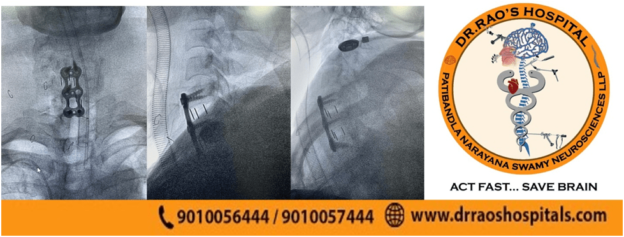Anterior Cervical Discectomy and Fusion (ACDF) – the best at Dr Raos, Guntur
Introduction
Anterior cervical discectomy and fusion (ACDF) is a surgical procedure used to treat neck pain and other symptoms associated with cervical disc degeneration. The procedure involves removing the damaged disc and replacing it with a bone graft. The graft is then fused to the vertebrae above and below the disc space. This stabilizes the spine and relieves pressure on the nerves. ACDF is generally considered a safe and effective procedure. However, as with any surgery, there are risks involved. These include infection, bleeding, nerve damage, and problems with the bone graft. In some cases, the symptoms may not be completely relieved after surgery. Looking for the best neurosurgeon for your cervical or back problem look no further than Dr Raos hospital and Dr Rao, the best neurosurgery hospital and the best neurosurgeon, respectively.
Indications
Anterior cervical discectomy and fusion (ACDF) is indicated when there is herniation or degeneration of the intervertebral disc causing nerve root or spinal cord compression. This results in symptoms such as arm pain, numbness, tingling, or weakness. ACDF may also be indicated for instability or deformity of the spine.
Contraindications
There are several contraindications to anterior cervical discectomy and fusion (ACDF). These include but are not limited to: – Severe osteoporosis – Previous neck surgery – Infection in the area of the proposed surgery – Active cancer in the neck or upper spine – An unstable spine due to trauma Each patient is different and your surgeon will be able to best advise you if ACDF is right for you.
Procedure
The procedure for an anterior cervical discectomy and fusion (ACDF) is typically performed under general anesthesia. The patient is placed lying face down on the operating table. A small incision is made in the front of the neck, and the muscles are moved aside to expose the vertebrae. Using a microscope, the surgeon removes the damaged disc and any bone spurs that may be present. The space created by the removal of the disc is then filled with a bone graft, which will eventually fuse the two vertebrae together. In some cases, metal plates and screws are used to hold the vertebrae in place while the fusion occurs. The incision is then closed, and a neck collar or brace may be placed around the neck to immobilize it during healing. The surgery usually takes 1-2 hours to complete.
Complications
Complications are rare but can occur with any surgery. The most common complications after anterior cervical discectomy and fusion (ACDF) are dysphagia (difficulty swallowing), hoarseness, and vocal cord paralysis. These can usually be resolved with time and/or speech therapy. Other potential complications include: • Dural tear – this can occur when the surgeon accidentally tears the dura mater, the outermost layer of the meninges (the three membranes that surround the brain and spinal cord). A dural tear can cause a CSF leak, which can lead to meningitis (inflammation of the meninges). • Nerve root injury – this can occur if the surgeon damages the nerve roots as they are removing the disc. This can cause pain, numbness, or weakness in the affected area. • Spinal cord injury – this is a very rare complication that can occur if the surgeon damages the spinal cord during the procedure. This can result in paralysis below the level of injury. • Infection – this is a rare complication that can occur at the surgical site. Infections can usually be treated with antibiotics. • Blood clots – this is a rare complication that can occur if blood clots form in the veins of the legs or pelvis. Blood clots can travel to the lungs and cause a pulmonary embolism, which can be life-threatening.
Complication prevention
There are several ways to prevent complications from occurring during an anterior cervical discectomy and fusion. First, it is important to have a thorough understanding of the procedure and what it entails. This includes knowing the risks and potential complications that can occur. Secondly, be sure to select a qualified surgeon who has experience performing this type of procedure. Third, follow all of the post-operative instructions given by the surgeon to ensure a successful recovery. Finally, if any complications do occur, be sure to seek medical attention immediately.
Conclusion
The conclusion of this article is that anterior cervical discectomy and fusion is a safe and effective procedure for treating herniated discs in the neck. The procedure has a low complication rate and can be performed with minimal invasiveness.


